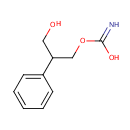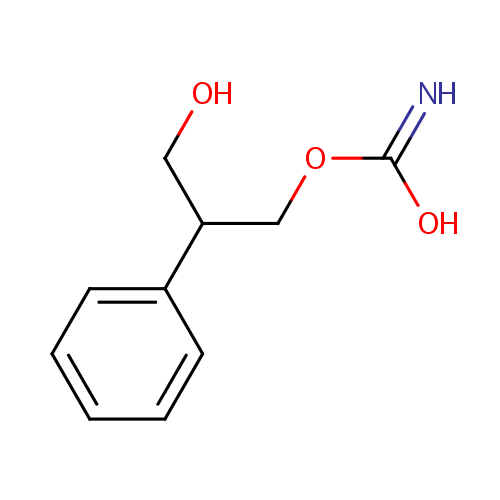|
Record Information |
|---|
| Version |
1.0 |
|---|
| Update Date |
1/22/2018 11:54:54 AM |
|---|
|
Metabolite ID | PAMDB000897 |
|---|
|
Identification |
|---|
| Name: |
2-Phenyl-1,3-propanediol monocarbamate |
|---|
| Description: | 2-phenyl-1,3-propanediol monocarbamate is a member of the chemical class known as Aromatic Homomonocyclic Compounds. These are aromatic compounds containig only one ring, which is homocyclic. |
|---|
|
Structure |
|
|---|
| Synonyms: | - 1,3-Propanediol, 2-phenyl-, monocarbamate
- 1,3-Propanediol, 2-phenyl-, monocarbamic acid
- 2-Phenyl-1,3-propanediol monocarbamic acid
- 2-Phenyl-3-hydroxypropyl carbamate
- 2-Phenyl-3-hydroxypropyl carbamic acid
|
|---|
|
Chemical Formula: |
C10H13NO3 |
|---|
| Average Molecular Weight: |
195.2151 |
|---|
| Monoisotopic Molecular
Weight: |
195.089543287 |
|---|
| InChI Key: |
JQVQIZWJBLGVRW-UHFFFAOYSA-N |
|---|
| InChI: | InChI=1S/C10H13NO3/c11-10(13)14-7-9(6-12)8-4-2-1-3-5-8/h1-5,9,12H,6-7H2,(H2,11,13) |
|---|
| CAS
number: |
25451-53-0 |
|---|
| IUPAC Name: | 3-(C-hydroxycarbonimidoyloxy)-2-phenylpropan-1-ol |
|---|
|
Traditional IUPAC Name: |
3-(C-hydroxycarbonimidoyloxy)-2-phenylpropan-1-ol |
|---|
| SMILES: | OCC(COC(O)=N)C1=CC=CC=C1 |
|---|
|
Chemical Taxonomy |
|---|
|
Taxonomy Description | This compound belongs to the class of organic compounds known as benzene and substituted derivatives. These are aromatic compounds containing one monocyclic ring system consisting of benzene. |
|---|
|
Kingdom |
Organic compounds |
|---|
| Super Class | Benzenoids |
|---|
|
Class |
Benzene and substituted derivatives |
|---|
| Sub Class | Not Available |
|---|
|
Direct Parent |
Benzene and substituted derivatives |
|---|
| Alternative Parents |
|
|---|
| Substituents |
- Monocyclic benzene moiety
- Carboximidic acid derivative
- Hydrocarbon derivative
- Primary alcohol
- Organooxygen compound
- Organonitrogen compound
- Imine
- Alcohol
- Aromatic homomonocyclic compound
|
|---|
| Molecular Framework |
Aromatic homomonocyclic compounds |
|---|
| External Descriptors |
Not Available |
|---|
|
Physical Properties |
|---|
| State: |
Not Available |
|---|
| Charge: | -1 |
|---|
|
Melting point: |
Not Available |
|---|
| Experimental Properties: |
|
|---|
| Predicted Properties |
|
|---|
|
Biological Properties |
|---|
| Cellular Locations: |
Cytoplasm |
|---|
| Reactions: | |
|---|
|
Pathways: |
Not Available |
|---|
|
Spectra |
|---|
| Spectra: |
|
|---|
|
References |
|---|
| References: |
- Kanehisa, M., Goto, S., Sato, Y., Furumichi, M., Tanabe, M. (2012). "KEGG for integration and interpretation of large-scale molecular data sets." Nucleic Acids Res 40:D109-D114. Pubmed: 22080510
|
|---|
| Synthesis Reference: |
Not Available |
|---|
| Material Safety Data Sheet (MSDS) |
Not Available |
|---|
|
Links |
|---|
| External Links: |
|
|---|


